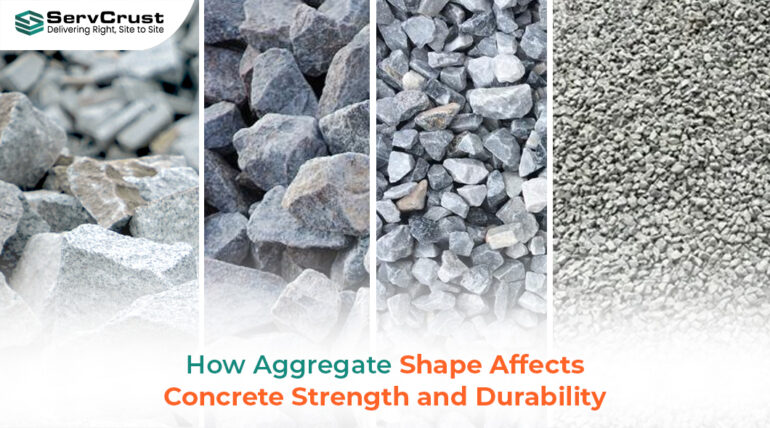
In any construction project, the strength and long-term durability of concrete matter more than most people realize. Whether it’s a building foundation, a pavement, or a flyover, the material holding everything together is expected to stay solid for decades. And one important factor to that strength is the shape of the aggregates mixed into concrete.
In Stone Aggregates both fine and coarse aggregates play a major role in determining the performance of concrete. From crushed stone and gravel to recycled aggregates, these materials form the structure of concrete mixes. But it’s not just the size that matters. The aggregate shape has a direct impact on how well the concrete performs under pressure.
What Are Aggregates in Concrete?
Definition and Types
Aggregates are the granular materials like crushed stone, gravel, and recycled concrete used to fill up the majority of volume in a concrete mix. These materials combine with cement and water to form concrete. Aggregates help reduce shrinkage, add strength, and lower the cost of the mix.
There are different types of aggregates: natural sand, stone aggregates, crushed stone aggregate, and recycled aggregates. Their source and physical properties affect how concrete behaves after setting.
Fine vs Coarse Aggregates
Aggregates are classified as fine or coarse. Fine aggregates are smaller particles like sand. Coarse aggregates include larger particles like 10mm aggregate, 20mm aggregate, 40mm aggregate, and 6mm aggregate. Coarse materials carry the load in concrete while fine aggregates fill the gaps and help with workability.
Types of Aggregate Shapes
Angular Aggregates
These are sharp-edged and made by crushing rocks. They interlock well, offer high friction, and contribute to higher compressive strength of concrete. Their rough texture helps in strong bonding with cement paste.
Rounded Aggregates
Naturally found in riverbeds, these have a smooth, spherical shape. While they improve workability and reduce the need for water, they don’t bond as strongly. That leads to lower concrete strength in structural applications.
Flaky Aggregates
Flaky particles are thin and flat, with poor packing characteristics. They create more voids and weak points in concrete, leading to lower concrete crushing strength. They are not recommended for high-strength or load-bearing structures.
Cubical Aggregates
These are uniformly shaped with ideal proportions. Cubical aggregates balance both strength and workability. They are preferred in construction for durable concrete as they offer better compaction and reduce voids.
How Aggregate Shape Influences Concrete Properties
Compressive Strength of Concrete
Shapes like angular and cubical particles help concrete resist loads better. They create a strong internal structure that supports more weight without cracking. Flaky shapes, in contrast, break the bond within the mix.
Workability and Water Demand
Smooth, rounded aggregates make concrete easier to pour and level. But this advantage comes at a cost they don’t form a strong internal lock. Angular aggregates need more water to flow well, but they contribute more to long-term performance.
Durability and Long-Term Performance
The durability of a concrete structure often depends on how tightly the aggregates can pack together. Cubical and angular particles interlock efficiently, leaving fewer gaps. This reduces water penetration and improves resistance to weather and time.
Practical Considerations in Choosing Aggregate Shape
Project Requirements
Different projects need different concrete behaviors. Roads need toughness, pavements need surface finish, and buildings need strength. Crushed aggregate is ideal for roads and buildings. Gravel and recycled concrete may suit non-structural works.
Sourcing and Aggregate Suppliers
Choosing the right aggregate suppliers is as important as choosing the right shape. Look for reliable providers offering tested coarse aggregate sizes like 20mm aggregate, 10mm, 6mm, and even 12mm aggregate for specific uses. Many builders now order from verified construction material platforms online.
Case Study: Real-World Application
A recent building project in South India compared concrete performance using flaky vs cubical aggregates. The compressive and bending strength of concrete was significantly higher with cubical aggregates. Even after 90 days, the concrete with cubical stones showed minimal surface cracks.
This test also highlighted differences in aggregate impact value, with angular particles offering higher resistance under stress.
Conclusion
The shape of your aggregates is more than a technical detail. It’s a decision that impacts safety, strength, and the life of the structure. Angular and cubical aggregates are the preferred choice for any load-bearing or long-lasting concrete work.
For high-quality crushed stone, aggregates, or construction aggregates, trust tested materials. ServCrust offers a range of reliable aggregate options delivered across Andhra Pradesh and Telangana. Order today by calling us or send a message “Hi” on WhatsApp to 8811881111.
